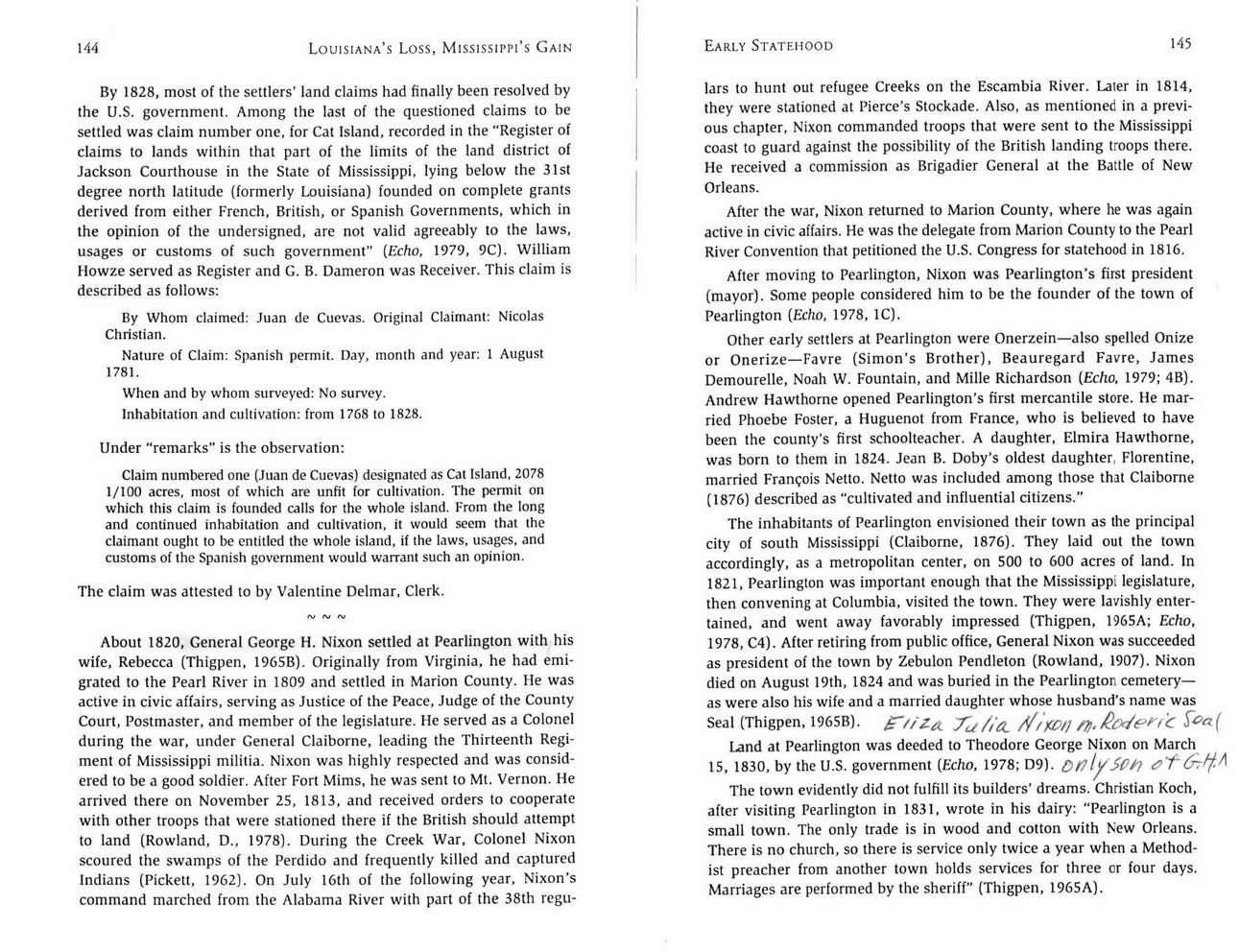This text was obtained via automated optical character recognition.
It has not been edited and may therefore contain several errors.
144 Louisiana?s Loss, Mississippi?s Gain By 1828, most of the settlers? land claims had finally been resolved by the U.S. government. Among the last of the questioned claims to be settled was claim number one, for Cat Island, recorded in the ?Register of claims to lands within that part of the limits of the land district of Jackson Courthouse in the State of Mississippi, lying below the 31st degree north latitude (formerly Louisiana) founded on complete grants derived from either French, British, or Spanish Governments, which in the opinion of the undersigned, are not valid agreeably to the laws, usages or customs of such government? [Echo, 1979, 9C). William Howze served as Register and G. B. Dameron was Receiver. This claim is described as follows: By Whom claimed: Juan de Cuevas. Original Claimant: Nicolas Christian. Nature of Claim: Spanish permit. Day, month and year: 1 August 1781. When and by whom surveyed: No survey. Inhabitation and cultivation: from 1768 to 1828. Under ?remarks? is the observation: Claim numbered one (Juan de Cuevas) designated as Cat Island, 2078 1/100 acres, most of which are unfit for cultivation. The permit on which this claim is founded calls for the whole island. From the long and continued inhabitation and cultivation, it would seem that the claimant ought to be entitled the whole island, if the laws, usages, and customs of the Spanish government would warrant such an opinion. The claim was attested to by Valentine Delmar, Clerk. f\j r\t /v About 1820, General George H. Nixon settled at Pearlington with his wife, Rebecca (Thigpen, 1965B). Originally from Virginia, he had emigrated to the Pearl River in 1809 and settled in Marion County. He was active in civic affairs, serving as Justice of the Peace, Judge of the County Court, Postmaster, and member of the legislature. He served as a Colonel during the war, under General Claiborne, leading the Thirteenth Regiment of Mississippi militia. Nixon was highly respected and was considered to be a good soldier. After Fort Mims, he was sent to Mt. Vernon. He arrived there on November 25, 1813, and received orders to cooperate with other troops that were stationed there if the British should attempt to land (Rowland, D., 1978). During the Creek War, Colonel Nixon scoured the swamps of the Perdido and frequently killed and captured Indians (Pickett, 1962). On July 16th of the following year, Nixon?s command marched from the Alabama River with part of the 38th regu- Early Statehood 145 lars to hunt out refugee Creeks on the Escambia River. Later in 1814, they were stationed at Pierce?s Stockade. Also, as mentioned in a previous chapter, Nixon commanded troops that were sent to the Mississippi coast to guard against the possibility of the British landing troops there. He received a commission as Brigadier General at the Battle of New Orleans. After the war, Nixon returned to Marion County, where he was again active in civic affairs. He was the delegate from Marion County to the Pearl River Convention that petitioned the U.S. Congress for statehood in 1816. After moving to Pearlington, Nixon was Pearlington?s first president (mayor). Some people considered him to be the founder of the town of Pearlington (Echo, 1978, 1C). Other early settlers at Pearlington were Onerzein?also spelled Onize or Onerize?Favre (Simon?s Brother), Beauregard Favre, James Demourelle, Noah W. Fountain, and Mille Richardson (Echo, 1979; 4B). Andrew Hawthorne opened Pearlington?s first mercantile store. He married Phoebe Foster, a Huguenot from France, who is believed to have been the county?s first schoolteacher. A daughter, Elmira Hawthorne, was born to them in 1824. Jean B. Doby?s oldest daughter, Florentine, married Francois Netto. Netto was included among those that Claiborne (1876) described as ?cultivated and influential citizens.? The inhabitants of Pearlington envisioned their town as the principal city of south Mississippi (Claiborne, 1876). They laid out the town accordingly, as a metropolitan center, on 500 to 600 acres of land. In 1821, Pearlington was important enough that the Mississippi legislature, then convening at Columbia, visited the town. They were lavishly entertained, and went away favorably impressed (Thigpen, 1965A; Echo, 1978, C4). After retiring from public office, General Nixon was succeeded as president of the town by Zebulon Pendleton (Rowland, 1907). Nixon died on August 19th, 1824 and was buried in the Pearlington cemetery? as were also his wife and a married daughter whose husband?s name was Seal (Thigpen, 1965B). Tu/ia. ///'&>/} M.&Oden'c S#a( Land at Pearlington was deeded to Theodore George Nixon on March 15, 1830, by the U.S. government (Echo, 1978; D9). OfllySCft 0"f~OrffA The town evidently did not fulfill its builders? dreams. Christian Koch, after visiting Pearlington in 1831, wrote in his dairy: ?Pearlington is a small town. The only trade is in wood and cotton with New Orleans. There is no church, so there is service only twice a year when a Methodist preacher from another town holds services for three or four days. Marriages are performed by the sheriff? (Thigpen, 1965A).

Nixon Journal-of-Mississippi-History-Vol.-XXXIX-No.-4-November-77-An-Editor's-Views-on-Anti-Cruelty-Eliza-Jane-Nicholson-of-the-Picayune--3